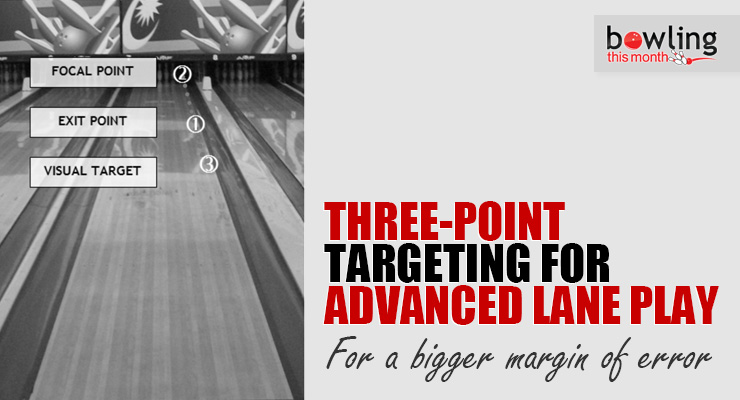Article Contents
- 1. The three targets
- 1.1. Step #1: Determine the exit point based on the pattern length
- 1.2. Step #2: Determine a focal point to set launch angle
- 1.3. Step #3: Choose an appropriate visual target
- 1.4. Step #4: Draw an imaginary line: Focal – Exit Point – Visual Target
- 1.5. Step #5: Set your feet parallel and body perpendicular to target line
- 1.6. Step #6: Visualize a successful shot in your mind on the target line
- 2. Lots of moves
Note: This article is only available to Bowling This Month subscribers.
I’d like to present an advanced lane play targeting method, a Three-Point Target System, which is based on research and has been developed to help provide you with the biggest margin of error. This should provide you with guidance to play any lane condition more appropriately, insuring more pocket shots, more strikes and less splits. Consequently, with this three-point system, you will be less likely overplay the lane.
As a full-time bowling coach, one of my missions is to develop simple-to-use systems for bowlers in order to significantly improve their margin of error and increase consistency. With this goal, I have taken the ideas of two BTM contributors, modified them, and built a hopefully improved targeting system.
Accordingly, to begin, I want to acknowledge Del Warren and Neil Stremmel’s previous contributions that acted as inspiration for this targeting model. Specifically, I have attempted to draw on and expand on the ideas of the exit point as well as focal point targeting. Both contributions appeared in the pages of BTM. Warren’s article, Sport Bowling: Targeting for Success, appeared in the December 2005 issue and Neil Stremmel’s Entry Angle – Part 3 appeared in the April 2006 issue.
From two ideas in these articles, along with other previously known targeting facts, I have developed a three-point targeting system that should lead to improved targeting for advanced bowlers, offering more consistency and accuracy in hitting the pocket. With the three-point system, you should have the most margin of error and keep yourself on a higher scoring pace for a longer period of time.
The three targets
The three-point targeting system uses three targets: an exit point, a focal point, and a visual target. With three targets, you should be able to establish a more accurate ball path by subconsciously creating more accuracy and better preparation for execution in your mind…prior to the shot.
Point 1: Initially in this process, the bowler determines an exit point based on an easy-to-use formula. The exit point is the actual board, at the end of the oil pattern, in which research informs us the ball should leave the oil pattern to increase the likelihood of hitting the pocket and striking.
Point 2: We choose a focal point at the end of the lane to establish an appropriate launch angle and body position.
Point 3: Lastly, a bowler chooses a visual target. This is the actual place a bowler will look at and attempt to hit. Using both the exit point and focal point guides a bowler to the best visual target to use.
The bowler should visualize the actual path through these three targets, from focal through the exit to the visual target. This visualization process prepares the subconscious mind to execute an outstanding shot with ...
Already a premium member? Click here to log in.


